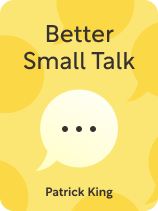

This article is an excerpt from the Shortform book guide to "Better Small Talk" by Patrick King. Shortform has the world's best summaries and analyses of books you should be reading.
Like this article? Sign up for a free trial here.
Do people consider you a sparkling conversationalist? Would you like to make your exchanges less predictable and boring?
For a long time, orators have known that storytelling in speeches goes a long way. Stories hold people’s attention, and they powerfully convey messages. The same is true in basic conversation. However, your conversations will feel a lot less basic once you start telling engaging stories when you talk with others.
Keep reading to learn how to use stories in conversation to powerful effect.
Using Stories in Conversation
In his book Better Small Talk, social interaction specialist Patrick King helps you master the basics of small talk and sustaining a dialogue. Then, he shows how you can “level up” to being an engaging conversationalist who’s fun to talk to. King asserts that being engaging in conversation simply means being good at telling stories. People would rather hear an interesting story that doesn’t have much to do with what you were talking about than have a predictable exchange.
(Shortform note: Author and story consultant Robert McKee explains why humans are so drawn to stories: Stories add meaning to our lives by showing us important truths about the world. Even a short story told in a conversation can be meaningful to someone else: Telling someone about a terrible date you had speaks to the universal truth that finding a true connection with others can be hard and might resonate especially with people in a similar situation.)
King adds that another benefit of using stories in conversation is that it helps you share details that will resonate with others or paint a picture of who you are. This, in turn, makes people feel more invested in your story and in you. For instance, if you describe feeling “like Homer Simpson” while driving home from work, a fan of The Simpsons might find this particularly funny and feel a stronger connection to you because of the reference. Telling the story in this way also creates a vivid image in the listener’s mind, which makes the story more engaging and reveals something about you (in this case, that you don’t take yourself too seriously and that you might have road rage).
(Shortform note: Sharing details about yourself requires you to be vulnerable. You can’t predict how the other person will react when you put something about yourself out there, and it’s possible they’ll disapprove of what you say. To make it easier to be vulnerable in conversation, try to free yourself from others’ expectations and talk and behave only in ways that feel authentic. Brené Brown writes that you can work toward this goal by developing a mantra, a phrase you say to yourself when you feel uncomfortable or in doubt. A conversational mantra you might use if you sense your conversation partner isn’t receptive might be: “The only thing that matters is that I’m being myself.”)
To become a better storyteller, first recognize that you can create a compelling story out of any quotidian event. The level of engagement you achieve has more to do with how you tell the story than the events you’re describing. To tell a story well, King recommends keeping the story limited to one sentence describing one event, which evokes one sentiment (a structure he refers to as the 1:1:1 rule). Keeping your story short and specific ensures you don’t ramble and gives a clear reason for the story—to evoke laughter, amazement, and so on.
(Shortform note: You may need to practice the 1:1:1 rule before you can master it, which might feel contrived and unnatural—after all, a conversation is meant to be spontaneous. If that’s the case, consider that even stand-up jokes—which are meant to sound extremely natural and conversational—require significant pre-planning. Comedian Jerry Seinfeld, for instance, meticulously prepares his jokes over months or even years to make them as funny as possible and to perfect his delivery. While you likely can’t invest that sort of time into your own brief stories, it might be worth thinking a little more deeply about how to make your story engaging and paying attention to your audience’s feedback so you can use it to improve.)
How to Tell Mini-Stories
King also specifically recommends preparing what he calls “mini-stories” about your life that you can tell in a variety of situations. A mini-story should be three sentences, and you should come up with a mini-story for common conversational topics, like work, your hometown, your week or weekend, and so on.
For instance, your mini-story about your hometown might be: “I grew up in a really nondescript town in the middle of nowhere. Our biggest claim to fame is that President Millard Fillmore once drove through it and said it was ‘forgettable’—which is saying something since people barely even remember who he was!”
(Shortform note: If you still feel nervous about telling stories in conversation, it can be helpful to recognize that the human brain is hardwired to enjoy stories. Story coach Lisa Cron says in Wired for Story that in the distant past, we used stories to convey and acquire important survival information. She adds that our story-oriented brain expects to receive three pieces of information in any story, so, in addition to condensing your story into three sentences, you might try to provide the following information: Who the story’s about, what’s the story’s about (the plot, or events), and what’s at stake (what bad thing might happen). If you keep your story short and you engage the reader by answering these three questions, it’s unlikely your story will fall flat.)

———End of Preview———
Like what you just read? Read the rest of the world's best book summary and analysis of Patrick King's "Better Small Talk" at Shortform.
Here's what you'll find in our full Better Small Talk summary:
- Why small talk is a critical part of any conversation
- How mastering small talk can help you have more meaningful conversations
- How to become a better conversationalist, storyteller, and listener






